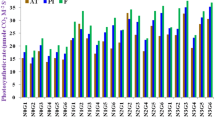Summary
Comparative efficiency of ammonium and nitrate nitrogen source, for growth of rice has been studied under solution culture technique. It is seen that:—
-
(a)
At moderate level of nitrogen (20 p.p.m.), ammonium and nitrate nitrogen are equally good nitrogen sources from the point of nitrogen uptake and grain yield but straw yield is higher with ammonium nitrogen.
-
(b)
At high nitrogen supply (100 p.p.m.), nitrate nitrogen is superior to ammonium nitrogen as the latter gives restricted root growth and disturbed nitrogen metabolism in the leaf tissue resulting in higher accumulation of soluble nitrogen to protein nitrogen.
-
(c)
Nitrate nitrogen is found to promote uptake of potassium, calcium, magnesium, manganese and phosphate by rice plant.
-
(d)
Comparatively better growth and crop yield is obtained with ammonium nitrogen given up to ear-initiation and nitrate nitrogen at later growth. Ammonium nitrogen is, therefore, suitable during vegetative stage for increasing tillering capacity, while nitrate nitrogen is preferred by the plant at the elongation and reproductive stage. It is suggested that this preference for nitrogen source is related to the oxidation reduction character of the plant root at different stages of plant growth.
Authors are indebted to Mr. R. L. M. Ghose, Director, Central Rice Research Institute, Cuttack, for his suggestion which helped improvement in the text of the paper.
Similar content being viewed by others
References
Abichandani, C. T. and Patnaik, S.Rice News Teller, 1958,6(2), 8.
Arnon, D. I...Soil Sci., 1937,44, 91.
—————.. Ibid., 1939,48, 295.
Asana, R. D...Indian J. Agric. Sci., 1945,15, 227.
Dastur, R. H... Ibid., 1940,10, 761.
—— and Kalyani, V. V. Ibid., 1934,4, 803.
—— and Malkani, T. J. Ibid., 1933,3, 157.
—— and Pirzada, A. R. Ibid., 1933,3, 963.
Espino, R. B...Phil. Agri., 1922,10, 313.
—— and Estioko, R. P. Ibid., 1931,20, 27.
Gericke, W. F...Soil Sci., 1930,29, 207.
Mitsui, S...Inorganic Nutrition Fertilization and Soil Amelioration for Lowland Rice, Yokendo Ltd., Tokyo, Japan (reprint), 1955, 17.
Tanaka, A., Patnaik, S. and Abichandani, C. T.Proc. Ind. Acad. Sci., 1958a,47 B, 140.
—————.. Ibid., 1958b,48 B, 14.
—————.. Ibid., 1959,49 B, 207.
Thelin, G. and Beaumont, A. B.J. Amer. Soc. Agron., 1934,26, 1012.
Author information
Authors and Affiliations
Additional information
Communicated by Mr. R. L. M. Ghose,f.a.sc.
Rights and permissions
About this article
Cite this article
Tanaka, A., Patnaik, S. & Abichandani, C.T. Studies on the nutrition of rice plant (Oriza sativa L.). Proc. Indian Acad. Sci. 49, 386–396 (1959). https://doi.org/10.1007/BF03053874
Received:
Issue Date:
DOI: https://doi.org/10.1007/BF03053874




